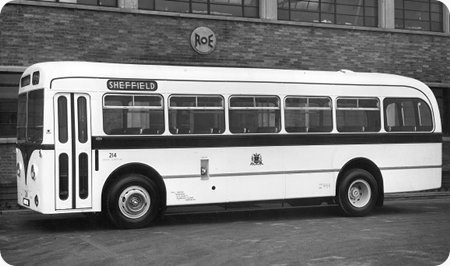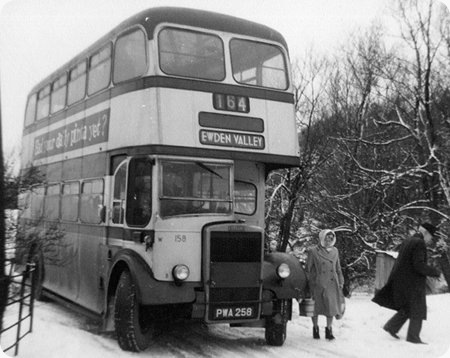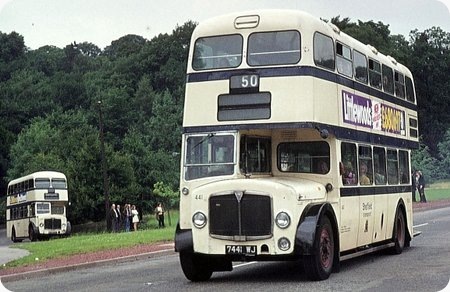Sheffield Corporation – AEC Regal IV – OWB 14 – 214

Copyright ‘unknown’ if you know please get in touch
Sheffield Corporation
1952
AEC Regal IV 9821S
Roe B44F
Sheffield quickly tried out underfloor engined single deckers when they became available with three Leyland Olympics in 1951 and three of these Roe bodied AEC Regal IV in 1952. Notably, all were for the A fleet although I recall the Olympics in particular being regular performers on the C service 48 to Manchester despite their bus seats. The Regal IVs always seemed to be out of the limelight certainly later in life being used on workmens services to the east end of the City. Of particular note is that these three were owned initially by ACV Sales being purchased by Sheffield in 1954. This photograph shows the legal owner as the Secretary of ACV Sales at 49 Berkeley Square in London. The Sheffield coat of arms is displayed but without a fleet name. Notable is the City of Oxford like vee shape on the front panel which was retained throughout their lives except for 213 which later had an all cream front panel probably as a result of accident damage repairs. There is a substantial semaphore trafficator arm behind the entrance doors. It is hard to imagine what an impact these vehicles must have made being so different from the then standard half cab single decker and with ten more seats. The photo is taken outside the Roe factory in Leeds.
Photograph and Copy contributed by Ian Wild
A full list of Regal IV codes can be seen here.
———
16/03/11 – 10:05
AEC? Roe? Perfection? …..and yet these beasts eluded me in my Sheffield childhood. I was a regular passenger on the back-loader Leylands, though. Fascinating about the early ACV ownership – presumably as demonstrators.
I love the Regal IV, especially the RF, but these were a minority with synchromesh gearboxes. Contemporary SUT RegalIV/Windover coaches had a of majority pre-select gearboxes – but even these had a minority of synchros.
As a "heavyweight" man, I never bought into the "over-engineered" tag given to the Regal IV (and Royal Tigers). The heavy Reliance and Leopard righted this wrong but we had to go through a period when I thought vehicles were under-engineered – especially when Tiger Cubs had 0.350 engines.
David Oldfield
———
17/03/11 – 06:58
I used to go to the Sheffield Depot of Independent TD Alexander (Greyhound) on a Saturday afternoon. There was a fitter there who worked for Sheffield Transport at Greenland Road Depot (apparently Sheffield knew of this arrangement) where the three Regal IV were based at that time. He told me one day that they had sent all three out as Peak District extras on the preceding Bank Holiday Monday – and all three had to be towed back with clutch faults! I seem to recall a fair bit of trouble with the hydraulic clutch operation on the PMT Reliances, probably 214 et all had the same equipment.
Ian Wild
———
17/03/11 – 18:22
Notwithstanding their frailties, the longevity of these three buses amounting to 16/17 years service was no mean feat in Sheffield terms and compares favourably with the Leyland Olympics of the time. Perhaps their mechanical shortcomings were outweighed by the fact that they were bodied by Roe who had impressed the Department with the quality of the nine PD2’s of late 1951 for the Fulwood – Malin Bridge via Hunters Bar tram replacement.
John Darwent
———
17/03/11 – 19:22
I can empathise with John’s comments about the Roe bodywork, but would the clutch problems possibly be connected to the gearbox problems experienced by AEC and, subsequently Sheffield, with the early synchros?
I believe it was Classic Bus which carried an article about a catalogue of problems with the early AEC synchro boxes which Sheffield helped ACV to sort out. The OWE Roe/RegentIIIs, and possibly the 1953 RWBs, had crash boxes and all their synchromesh gearboxes were retrofitted.
The pre-select had been designed for the 9.6 engine in the RT; the crash was a pre-war box for the 7.7 engine. Mixing manual box and bigger engine took longer to sort out than expected. Even the giants with a reputation for quality could get it wrong; but they survived by eventually sorting things out.
David Oldfield
———
19/03/11 – 07:49
The OWE batches of Regent III delivered with Roe bodies in 1952 had 9613A chassis numbers ie constant mesh gearboxes as built. The PSV Circle notes that synchromesh gearboxes were fitted to these buses in 1953. The 1953 batch of RWA registered buses had 9613S chassis numbers ie synchromesh gearboxes as built.
The three Regal IV were withdrawn in 1968, ie 16 years service. The Olympics were withdrawn 1966/67/68 (2) ie 15,16,17 yrs of service. My recollection is that the Regals did relatively light duties (58 to Thorpe Hesley and 106 to Brookhouse Colliery – both Colliery/Works services – being typical). The Olympics were used latterly on the well loaded and hilly service 31 to Lower Walkley. probably due to CoF expiry dates Olympics 11 and 26 outlasted the rear entrance ‘crush loader’ Royal Tigers on this service. My notes at the beginning of 1968 show that at this time 26 was the oldest bus in the fleet and its last repaint was in December 1960 – ‘it looked rather shabby’. By comparison 11 (the ex Demonstrator) had been repainted in June 1966 and ‘had a full set of retrimmed seat cushions’.
Ian Wild
———
19/03/11 – 17:16
Thanks for clarification, Ian. I lived on the 31 until I was 5, when I moved to Greenhill. I do remember the Regal IVs being 58/Thorpe Hesley regulars.
David Oldfield
———
04/10/11 – 21:01
That AEC OWB 14 was a regular performer on route 40, Sheffield – Bakewell and was also used on the Bakewell school run via the Hope Valley, been on it many a time when I was at Lady Manners School 1953-56. I also recall another single decker RPA 221 which was a Surrey registration, but I can’t recall if it was a Leyland or AEC. Other AECs I remember on that route started with TWJ — reg at that time.
Chris Webb
———
05/10/11 – 06:38
Chris RPA 221 was an ex demonstrator Leyland Olympic, the registration a Surrey one, local to Weymann at Addlestone. The AECs you mention were the C fleet integral AEC/Park Royal Monocoaches
David Oldfield
Quick links to the - Comments Page - Contact Page - Home Page


